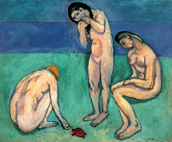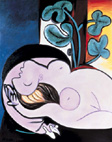Matisse Picasso seeks to chart the unique relationship between Henri
Matisse and Pablo Picasso, the two most famous artists of the twentieth
century, traditionally viewed as complementary or opposing forces. The
relationship between the two men was more complex and much closer, on
both psychological and visual levels, than has generally been
acknowledged. Over the years each came to regard the other as his only
true peer. Late in life, Picasso stated that time would show how in many
ways, he and Matisse had been following the same paths during the years
that they had established their artistic supremacy. Their initial
rivalry encouraged each artist to find his own clear and original voice.
Matisse Picasso consists of almost 140 works focusing primarily on
painting, with sculptures interspersed throughout and special sections
of works on paper which reinforce critical thinking raised by the
confrontations of works on canvas. The exhibition begins with
self-portraits executed by the artists in 1906, the year they met, and
with works they exchanged soon thereafter. Matisse was by then
established as leader of the Fauve movement, which represented
everything that was innovative and daring in French painting. Picasso,
although he had been recognized in Spain as a child prodigy, was still
something of an outsider in Paris. But shrewd observers already saw the
two men as the rival personalities most likely to influence future
developments in contemporary art.
The largest part of the exhibition concentrates on works produced
between 1907 and 1917, when the painters were in open competition and
created some of the finest art of the twentieth century. In this period,
the impact of Picasso’s Cubism is clearly evident in Matisse’s work.
Beginning in 1917, Matisse spent more time in Nice and reverted to a
more intimate, introspective, and naturalistic manner. Picasso stayed
mostly in Paris and was working in diverse styles and experiencing a
succession of new social and aesthetic worlds. The Surrealist ethos,
which Picasso did so much to foster, served to further distance the two
artists. Yet they continued to study each other’s work and respond to
each other in new ways. By the 1930s, their fame drew them increasingly
together.During the Second World War, Matisse and Picasso exchanged
further works and increasingly drew support from each other. After the
war, when Picasso moved to the South of France, their relationship
entered its final and closest phase. A concluding section of the
exhibition, which explores Matisse’s and Picasso’s acrobatic figures
(swimmers, dancers, and nudes) from the 1 920s onwards, focuses on the
latter years and the startling affinities between their works.
Because of the close cooperation between the four participating museums,
Matisse Picasso will be uniquely rich in confrontations between major
masterpieces never before physically juxtaposed.These will be reinforced
by generous loans from the Hermitage Museum in Saint Petersburg, the
Pushkin Museum in Moscow, and from two museums notably rich for their
holdings of works by Matisse: Statens Museum for Kunst in Copenhagen and
the Baltimore Museum of Art. Private collectors and the families of both
artists have been generously supportive of the exhibition.
Matisse Picasso examines the complex relationship of the two artists
through almost 140 works of painting and sculpture that span half a
century. The exhibition features rarely lent masterpieces from all over
the world as well as works from MoMA’s unparalleled Matisse and Picasso
collections. Unique to the MoMA showing will be seven works from every
period covered in the exhibition. Matisse Picasso demonstrates a
dialogue between the two giants of twentieth-century art, who in spite
of their lifelong rivalry came to see each other as true equals. The
exhibition is co-organized by The Museum of Modern Art, along with Tate
Modern, London, and the Reunion des musées nationaux /Musée Picasso,
Musée national d’art moderne /Centre Georges Pompidou, Paris.
|
-
-
THE MUSEUM OF MODERN ART PRESENT
MATISSE PICASSO
- Groundbreaking International Exhibition Explores Complex Relationship
Between Two Modern Masters
This
exhibition is a collaboration between The Museum of Modern Art, New
York, Tate Modern, London, and the Reunion des musées nationaux /Musée
Picasso, Musée national d’art moderne / Centre Georges Pompidou, Paris.
The curators are: John Elderfield, Chief Curator atLarge, The Museum of
Modern Art, New Yo Varnedoe, Professor of the History of Art, Scho Historical Studies, Institute for Advanced Study, Princeton;
John Golding, Painter and Art Historian, London; Elizabeth Cowling,
Senior Lecturer, Department of Fine Art, University of Edinburgh; Anne
Baldassari, Curator, Musée Picasso, Paris; and Isabelle Monod-Fontaine,
Deputy Director, Musée Nationale d’Art Moderne, Paris.
The
exhibition curators are John Elderfield, Chief Curator at Large, The
Museum of Modern Art, New York; Kirk Varnedoe, Professor of the History
of Art, School of Historical Studies, Institute for Advanced Study,
Princeton; John Golding, Painter and Art Historian, London; Elizabeth
Cowling, Senior Lecturer, Department of Fine Art, University of
Edinburgh; Anne Baldassari, Curator, Musee Picasso, Paris; and Isabelle
Monod-Fontaine, Deputy Director, Musee Nationale d’Art Moderne, Paris.
The exhibition and accompanying publication are sponsored by Merrill
Lynch.
A major grant is also provided by The Starr Foundation. The Museum
acknowledges generous support from an anonymous donor. An indemnity for
the exhibition has been granted by the Federal Council on the Arts and
the Humanities. Additional funding is provided by Monique M. Schoen
Warshaw.
|



